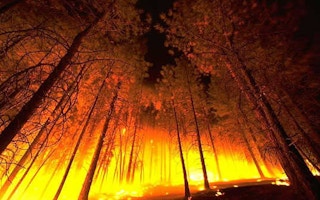The simplest way to describe fire worldwide is that there is too much of the wrong kind, too little of the right kind, and too much overall. The wrong kinds are those such as the blaze that just killed 19 firefighters here in Arizona, or those that have put southeast Asia under a pall, that incinerate communities, befoul ecosystems with effluents, and trash biotas by burning at the wrong times and intensities. The right kinds are those that perform an ecological service by burning landscapes properly – and that stay in their place.
Paradoxically, it is likely that there is not enough fire on the planet; but, thanks to fossil fuels, there is certainly too much combustion. Overall, the developed world has too few good fires, and the developing world has too many bad ones. Nearly every observer forecasts that this will continue over the coming years.
What to do about it depends on how we characterise the problem. The paradox of fire stems from its role as the great shape-shifter of natural processes. The reason is simple: fire is not a creature nor a substance nor a geophysical event like a hurricane or an earthquake. It is a biochemical reaction. It synthesizes its surroundings. It takes its character from its context.
Fire integrates everything around it – sun, wind, rain, plants, terrain, roofing, fields, and everything people do, and don’t do. In this way, it indexes the state of an ecosystem. It is also our signature act as a species, the one thing we do that no other creature does. While we did not invent fire (it has been integral to Earth for more than 400 million years), we exercise a monopoly over its controlled use.
All of this makes fire universal, difficult to grasp, and tricky to wrestle into manageable shape. There is no solution to fire, because there are many kinds of fires, and they change with their context. Some fire problems do have technical fixes. We can build machines that reduce combustion to its essence and contain it. We can erect houses that resist burning. We can design cities that prevent fires from spreading from building to building. But these fires are fixable only because we construct their settings.
We cannot survive without fire; we just need it in the right ways. It is certainly a problem when it burns freely through cities. But it is also a problem when it is removed from wildlands that have adapted to it, because its absence can be as ecologically significant as its presence. The point is, urban fire is not a model for wildland fire.
Our prevailing templates for describing fire are similarly misdirected. They portray the burn as a disaster and the fight against it as a war story. The battlefield allusion leads observers to reason that there must be more sophisticated technologies than shovels and rakes with which to suppress the flames. We must meet force with greater force. Such metaphors matter, because they mis-define the problem.
Over the past decade, the world has experienced a pattern of untrammeled burning – what some observers have termed “megafires.” Explanations vary. Some point to climate change, with global warming producing deeper droughts and more extreme weather. Some of these fires have raged under abnormal conditions; some have not.
Others emphasise a buildup of combustible materials. The nature of such fuel accumulations runs the gamut, including swamp drainage in Indonesia, rainforest destruction in Amazonia, self-thickening woods in American wildlands as a result of fire exclusion, and everywhere the intrusion of urban sprawl and fire-prone houses.
Still others blame changes in policy and practice. Lands legally recorded as wilderness will encourage more fire; and a reluctance to put firefighters at risk in remote settings – as well as cost concerns – argues for backing off and letting the next ridge burn while offering point protection for threatened communities.
Of course, we need the ability to control bad fires. But an emphasis on suppression alone leads to the fire equivalent of a police state, not to a livable landscape. Rather, the great diversity of fires points to the need for an equal diversity of means to cope with them or convert them to beneficial outcomes.
Matching problems with solutions requires us to characterize the issue properly. A fire that burns into a community is a disaster, but if we see fire only as a disaster, then we will follow the example of many wildland fire agencies that are adopting urban, all-hazard models in place of traditional land management. This leaves them fighting the fires that break out, rather than managing the settings that sustain those fires.
Likewise, if we define the fight against fire as a battlefield, we will build up our forces, search for more powerful technologies like air tankers, and accept firefighters’ deaths as inevitable. We will win battles, but kill crews in a war that does not exist. Even if we accept the war metaphor, we are engaged less in set-piece conflicts than in an ecological insurgency that we cannot bomb or bulldoze into submission. In many settings, the best solution is to use good fires to contain bad ones. A generalized war on fire is as ill-conceived as, say, a global war on terror.
Fire is what its setting makes it. It is also a relationship. Fire and humanity long ago began shaping each other’s realm. Today, as always, we remain the best of friends and the worst of enemies.
Stephen J Pyne is a professor at the School of Life Sciences at Arizona State University. This post originally appeared here.










